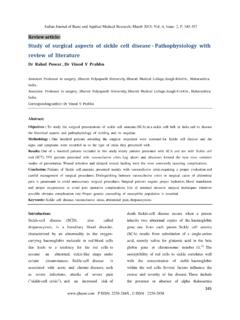Transcription of ORAL CHELATION THERAPY FOR PATIENTS WITH LEAD …
1 1 ORAL CHELATION THERAPY FOR PATIENTS WITH LEAD POISONING Jennifer A. Lowry, MD Division of Clinical Pharmacology and Medical Toxicology The Children s Mercy Hospitals and Clinics Kansas City, MO 64108 Tel: (816) 234-3059 Fax: (816) 855-1958 December 2010 2 TABLE OF CONTENTS 1. Background of Lead Poisoning ..3 a. Clinical Significance of Lead Measurements ..3 b. Absorption of Lead and Its Internal Distribution Within the Body ..3 c. Toxic Effects of Exposure to Lead in Children and Adults ..4 d. Reproductive and Developmental e. Mechanisms of Lead Toxicity ..6 f. Concentration of Lead in Blood Deemed Safe for g. Use of Blood Lead Measurements as a Marker of Lead Exposure ..7 2. Management of the Child with Elevated Blood Lead Concentrations.
2 8 a. Decreasing b. CHELATION 3. Oral CHELATION THERAPY ..8 a. Meso-2,3 dimercaptosuccinic acid (DMSA, Succimer) ..8 i. ii. Dosing ..9 iii. iv. b. Racemic-2,3-dimercapto-1-propanesulfonic acid (DMPS, Unithiol)..11 i. ii. Dosing ..12 iii. iv. c. i. ii. iii. iv. 4. Provocative Excretion Test for Lead Body 5. 6. 7. Draft Formulary for Meso-2,3-Dimercaptosuccinic Acid (DMSA) ..21 8. 3 Literature Review The studies for this review were identified by performing a search of the PubMed and Medline databases using the search terms: lead poisoning and CHELATION , lead poisoning and penicillamine , lead poisoning and DMSA , lead poisoning and succimer , lead poisoning and DMPS , and lead poisoning and provocative urine excretion , The dates included 1970-2007.
3 The Cochrane Database for Systematic Reviews was also searched; however, no pertinent reviews were found. The bibliographies of selected articles were also reviewed to identify any studies not found by the original literature search. Inclusion of articles was dependent on the age of the subjects or PATIENTS included in the literature, with primary focus on children under the age of 21 years. Background of Lead Poisoning Clinical Significance of Lead Measurements Lead poisoning, usually, is a chronic disease, due to cumulative intake of lead, the course of which may or may not be punctuated by acute symptomatic episodes. The clinical signs and symptoms of lead poisoning are nonspecific; therefore, a lead measurement, preferably a venous blood lead measurement, is essential for diagnosis.
4 Ancillary tests such as those involving heme precursors (urinary delta-aminolevulinic acid, coproporphyrin, and erythrocyte protoporphyrin) may be helpful in making a diagnosis, but by themselves are inadequate for definitive diagnosis. In the majority of cases, children with lead poisoning are asymptomatic resulting in a delay in the appropriate diagnosis. However, during this time effects on a cellular level are occurring resulting in subtle changes in the child. These include impairment of IQ and other cognitive effects, decreased heme synthesis, and interference in vitamin D metabolism. In children, overt clinical symptoms of cumulative lead poisoning generally begin with loss of appetite and abdominal pain.
5 They are, however, easily confused with other diseases that can cause the same symptoms. If the disease is not recognized at this stage, the clinical presentation in children may proceed to signs of increased intracranial pressure (projectile vomiting, altered state of consciousness, seizures). The total body burden of lead may be divided into four compartments. The residence times of lead in these four compartments are estimated at about: 35 days in blood; 40 days in soft tissues; 3 to 4 years in trabecular bone; and 16 to 20 years in cortical bone. The disappearance time is largely dependent upon the degree of overall excess exposure. The greater the body lead burden the slower the rate of disappearance from the tissues, including ,2 Blood lead measurements, however, may not be helpful in making a retrospective Injury from lead (for kidneys and CNS) may remain long after blood lead levels have decreased due to distribution and elimination.
6 At present, there is no established way to make a retrospective diagnosis of lead toxicity in a child on the basis of current blood lead alone. Absorption of Lead and Its Internal Distribution Within the Body Inorganic lead is absorbed by both the respiratory route and the gastrointestinal tract. Inorganic lead is not absorbed through the skin, although organic lead compounds Studies in the past have indicated that 40 to 50% of small-particulate lead is absorbed and retained in the Balance studies in young children show that 40 to 50% of dietary lead is absorbed, and that about one-half the amount absorbed is retained. Lead is distributed throughout the body with the major fraction being 4absorbed in the bone (95% in the adult and about 70 to 75% in young growing children).
7 6 The rate of turnover of lead in bone is higher in children than in adults. The two nonosseous organs with the highest lead contents are the liver and the kidney, the organs of excretion of lead. In general, the concentration of lead in other organs is comparable to that found in blood. Approximately 99% of the lead in blood is bound to red blood cells. The remaining 1%, , plasma lead, serves as an intermediate in transporting lead from the erythrocytes to other body compartments. Toxic Effects of Exposure to Lead in Children and Adults Lead affects at least three major organ systems: (1) the central and peripheral nervous systems; (2) the heme biosynthetic pathway; and (3) the renal system.
8 Clinical manifestations differ somewhat between children and adults. In the child, the most serious symptoms are found in the central nervous system with subtle effects ( , decreased IQ and cognitive effects) occurring at lower levels and severe effects ( , seizures, encephalopathy) occurring at higher levels. CHELATION THERAPY has reduced the mortality rate and morbidity substantially at higher levels. However, CHELATION THERAPY at lower levels (< 45 g/dL), it has not been shown to be as effective as removal of the lead source from the child s environment. Children are much more sensitive than adults to the neurocognitive and behavioral effects of lead, probably primarily for two reasons: (1) children absorb 40 to 50% of dietary lead whereas adults absorb about 10%; and (2) the nervous system develops rapidly in the young child.
9 The blood lead threshold (if there is one) for neurocognitive and behavioral effects is probably lower in children than in ,7 In the child, lead appears to have an effect on renal function even at levels below 10 This especially true if the lead exposure occurs over a sustained period of time. Subtle abnormalities in renal tubular function, associated with aminoaciduria, glycosuria, and increased excretion of low-molecular weight proteins can occur. Lead has been clearly demonstrated to produce tubular nephrotoxicity and chronic interstitial nephritis in humans and rodents after chronic exposure. In addition, lead in the kidney interferes with activation of vitamin D 1,2-dihydroxy cholecalciferol, a p450-dependent process.
10 5 Lead interferes in the formation of active vitamin D, which has an important role in its influence on calcium metabolism. Calcium is under tight homeostatic control in all The active form of Vitamin D is produced, primarily, from activation of Vitamin D by sunlight on the skin. The circulating hormone binds to Vitamin D Receptors (VDRs) in the nucleus of cells in the gastrointestinal tract, kidney and bone. This binding activates a cascade of events to increase calcium absorption. Because of their similar biochemical nature, lead can be absorbed by this mechanism especially in children who have decreased calcium intake. In addition, calbindin-D, the binding protein that aids in calcium transport, binds to lead with high affinity and may increase transport of lead in low calcium It is known that lead interferes with the utilization of iron for the formation of heme.

















